Anti-fascism
Anti-fascism is opposition to fascist ideologies, groups and individuals. The anti-fascist movement began in a few European countries in the 1920s, and eventually spread to other countries around the world. It was at its most significant shortly before and during World War II, where the Axis powers were opposed by many countries forming the Allies of World War II and dozens of resistance movements worldwide. Anti-fascism has been an element of movements holding many different political positions, including social democratic, nationalist, liberal, conservative, communist, Marxist, trade unionist, anarchist, socialist, republicanist, pacifist and centrist viewpoints.
| Part of a series on |
| Anti-fascism |
|---|
|
Core tenets |
|
Organizations and movements |
|
Tactics |
|

Origins
With the development and spread of Italian Fascism, i.e. original fascism, the National Fascist Party's ideology was met with increasingly militant opposition by Italian communists and socialists. Organizations such as the Arditi del Popolo[1] and the Italian Anarchist Union emerged between 1919–1921, to combat the nationalist and fascist surge of the post-World War I period.
In the words of historian Eric Hobsbawm, as fascism developed and spread, a "nationalism of the left" developed in those nations threatened by Italian irredentism (e.g. in the Balkans, and Albania in particular).[2] After the outbreak of World War II, the Albanian and Yugoslav resistances were instrumental in antifascist action and underground resistance. This combination of irreconcilable nationalisms and leftist partisans constitute the earliest roots of European anti-fascism. Less militant forms of anti-fascism arose later. For instance, during the 1930s in Britain, "Christians – especially the Church of England – provided both a language of opposition to fascism and inspired anti-fascist action".[3]
Michael Seidman argues that traditionally anti-fascism was seen as the purview of the political left but that in recent years this has been questioned. Seidman identifies two types of anti-fascism - revolutionary and counterrevolutionary (Seidman uses counterrevolutionary in a neutral sense, noting it is generally thought of as a pejorative). Revolutionary anti-fascism was expressed amongst communists and anarchists, where it identified fascism and capitalism as its enemies and made little distinction between fascism and other forms of authoritarianism. It did not disappear after the Second World War but was used as an official ideology of the Soviet bloc, with the "fascist" West as the new enemy. Counterrevolutionary anti-fascism was much more conservative in nature, with Seidman arguing Charles de Gaulle and Winston Churchill represent examples of it and they tried to win the masses to their cause. Counterrevolutionary antifascists desired to the ensure the restoration or continuation of the prewar old regime and conservative antifascists disliked fascism's erasure of the distinction between the public and private spheres. Like its revolutionary counterpart, it would outlast fascism once the Second World War ended. Seidman argues that despite the differences between these two strands of anti-fascism, there were similarities. They would both come to regard violent expansion as intrinsic to the fascist project. They both rejected any claim that the Versailles Treaty was responsible for the rise of Nazism and instead viewed fascist dynamism as the cause of conflict. Unlike fascism, these two types of anti-fascism did not promise a quick victory but an extended struggle against a powerful enemy. During WW2, both anti-fascisms responded to fascist aggression by creating a cult of heroism which relegated victims to a secondary position.[4] However, after the war, conflict arose between the revolutionary and counterrevolutionary anti-fascisms; the victory of the Western Allies allowed them to restore the old regimes of liberal democracy in Western Europe, while Soviet victory in Eastern Europe allowed to establish new revolutionary anti-fascist regimes there.[5]
History
Anti-fascist movements emerged first in Italy, during the rise of Mussolini, but soon spread to other European countries and then globally. In the early period, Communist, socialist, anarchist and Christian workers and intellectuals were involved. Until 1928, the period of the United front, there was significant collaboration between the Communists and non-Communist anti-fascists. In 1928, the Comintern instituted its ultra-left "Third Period" policies, ending co-operation with other left groups, and denouncing social democrats as "social fascists". From 1934 until the Molotov–Ribbentrop Pact, the Communists pursued a Popular Front approach, of building broad-based coalitions with liberal and even conservative anti-fascists. As fascism consolidated its power, and especially during World War II, anti-fascism largely took the form of Partisan or Resistance movements.
Italy: against Fascism and Mussolini
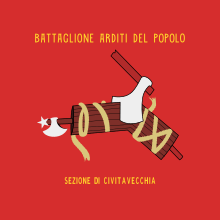
In Italy, Benito Mussolini's Fascist regime used the term "anti-fascist" to describe its opponents. Mussolini's secret police was officially known as Organizzazione per la Vigilanza e la Repressione dell'Antifascismo (OVRA), Italian for "Organization for Vigilance and Repression of Anti-Fascism").
In the Kingdom of Italy in the 1920s, anti-fascists—many from the labor movement—fought against the violent Blackshirts and against the rise of fascist leader Benito Mussolini. After the Italian Socialist Party (PSI) signed a pacification pact with Mussolini and his Fasces of Combat on 3 August 1921,[6] and trade unions adopted a legalist and pacified strategy, members of the workers' movement who disagreed with this strategy formed the Arditi del popolo. The General Confederation of Labour (CGL) and the PSI refused to officially recognize the anti-fascist militia, while the Communist Party of Italy (PCd'I) ordered its members to quit the organization. The PCd'I organized some militant groups, but their actions were relatively minor, and the party maintained a non-violent, legalist strategy. The Italian anarchist Severino Di Giovanni, who exiled himself to Argentina following the 1922 March on Rome, organized several bombings against the Italian fascist community.[7]
Italian liberal anti-fascist Benedetto Croce wrote Manifesto of the Anti-Fascist Intellectuals, which was published in 1925.[8] Other notable Italian liberal anti-fascists around that time was Piero Gobetti and Carlo Rosselli.[9]
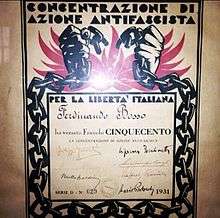
Concentrazione Antifascista Italiana (Italian Anti-Fascist Concentration) was an Italian coalition of Anti-Fascist groups which existed from 1927 to 1934. Founded in Nérac, France, by expatriate Italians, the CAI was an alliance of non-communist anti-fascist forces (republican, socialist, nationalist) trying to promote and to coordinate expatriate actions to fight fascism in Italy, and published a propaganda paper, entitled La Libertà.[10][11][12]
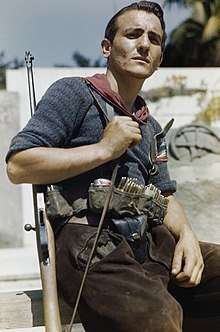
Between 1920 and 1943, several anti-fascist movements were active among the Slovenes and Croats in the territories annexed to Italy after World War I, known as the Julian March.[13][14] The most influential was the militant insurgent organization TIGR, which carried out numerous sabotages, as well as attacks on representatives of the Fascist Party and the military.[15][16] Most of the underground structure of the organization was discovered and dismantled by the Organization for Vigilance and Repression of Anti-Fascism (OVRA) in 1940 and 1941,[17] and after June 1941, most of its former activists joined the Slovene Partisans.
During World War II, many members of the Italian resistance left their homes and went to live in the mountainside, fighting against Italian fascists and German Nazi soldiers. Many cities in Italy, including Turin, Naples and Milan, were freed by anti-fascist uprisings.[18]
Slovenians and Croats under Italianization
The anti-fascist resistance emerged within the Slovene minority in Italy (1920–1947), who the Fascists meant to deprive of their culture, language and ethnicity. The 1920 burning of the National Hall in Trieste, the Slovene center in the multi-cultural and multi-ethnic Trieste by the Blackshirts,[19] Benito Mussolini who, at the time, was yet to become Duce, praised as a being a "masterpiece of the Triestine fascism" (capolavoro del fascismo triestino).[20] Not only in multi-ethnic areas, but also in the areas where the population was exclusively Slovene, the use of Slovene language in public places, including churches, was forbidden.[21] Children, if they spoke Slovene, were punished by Italian teachers who were brought by the Fascist State from Southern Italy. The Slovene teachers, writers, and clergy were sent to the other side of Italy.
The first anti-fascist organization, called TIGR, was formed by Slovenes and Croats in 1927 in order to fight Fascist violence. Its guerrilla fight continued into the late 1920s and 1930s when by the mid-1930s, already 70,000 Slovenes fled Italy mostly to Slovenia (then part of Yugoslavia) and South America.
The Slovene anti-fascist resistance in Yugoslavia during World War II was led by Liberation Front of the Slovenian People. The Province of Ljubljana, occupied by Italian Fascists, saw the deportation of 25,000 people, equaling 7.5% of the total population, filling up Rab concentration camp and Gonars concentration camp and other Italian concentration camps.
Germany: against the NSDAP and Hitlerism

In Weimar Republic-era Germany the movement of National Socialism which grew ever more influential in the last years of the republic was opposed for different ideological reasons by a wide variety of groups, including groups which also opposed each other, such as social democrats, centrists, conservatives and communists. The SPD and centrists formed the Reichsbanner Schwarz-Rot-Gold in 1924 to defend liberal democracy against both the Nazi Party and the KPD, and their affiliated organizations. Later mainly SPD members formed the Iron Front which opposed the same groups.[22]
The specific term anti-fascism was primarily used by the Communist Party of Germany (KPD), which held the view that it was the only anti-fascist party in Germany. The KPD formed several explicitly anti-fascist groups, such as the Roter Frontkämpferbund (formed in 1924 and banned by the social democrats in 1929) and the Kampfbund gegen den Faschismus (a de facto successor to the latter).[23][24][25] In 1932 the KPD established the Antifaschistische Aktion as a "red united front under the leadership of the only anti-fascist party, the KPD".[26] Under the leadership of the committed Stalinist Ernst Thälmann, the KPD primarily viewed fascism as the final stage of capitalism rather than as a specific movement or group, and therefore applied the term broadly to its opponents, and in the name of anti-fascism the KPD focused in large part on attacking its main adversary, the centre-left Social Democratic Party of Germany, whom they referred to as social fascists and regarded as the "main pillar of the dictatorship of Capital."[27]
The name and logo of Antifaschistische Aktion remain influential; its two-flag logo, designed by Max Keilson and Max Gebhard, is still widely used as a symbol of militant anti-fascists in Germany and globally,[28] as is the Iron Front's Three arrows logo.[29]
Spain: Civil War with the Nationalists
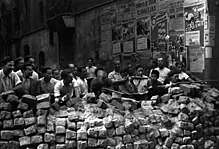
"The Spanish civil war was both at the centre and on the margin of the era of anti-fascism. It was central, since it was immediately seen as a European war between fascism and anti-fascism, almost as the first battle in the coming world war, some of the characteristic aspects of which - for example, air raids against civilian populations - it anticipated"[30]
In Spain, there were histories of popular uprisings in the late 19th century through the 1930s against the deep-seated military Dictatorships[31]
of General Prim and the Primo de la Rivieras[32] These movements further coalesced into large-scale anti-fascist movements in the 1930s, many by the Basque Country, before and during the Spanish Civil War. The republican government and army, the Antifascist Worker and Peasant Militias (MAOC) linked to the Communist Party (PCE),[33] the International Brigades, the Workers' Party of Marxist Unification (POUM), Spanish anarchist militias, such as the Iron Column and the autonomous governments of Catalonia and the Basque Country, fought the rise of Francisco Franco with military force. The Friends of Durruti, associated with the Federación Anarquista Ibérica (FAI), were a particularly militant group. Thousands of people from many countries went to Spain in support of the anti-fascist cause, joining units such as the Abraham Lincoln Brigade, the British Battalion, the Dabrowski Battalion, the Mackenzie-Papineau Battalion, the Naftali Botwin Company and the Thälmann Battalion, including Winston Churchill's nephew, Esmond Romilly.[34] Notable anti-fascists who worked internationally against Franco included: George Orwell (who fought in the POUM militia and wrote Homage to Catalonia about this experience), Ernest Hemingway (a supporter of the International Brigades who wrote For Whom the Bell Tolls about this experience), and radical journalist Martha Gellhorn.
Spanish anarchist guerrilla Francesc Sabaté Llopart fought against Franco's regime until the 1960s, from a base in France. The Spanish Maquis, linked to the PCE, also fought the Franco regime long after the Spanish Civil war had ended.[35]
France: against Action Française and Vichy
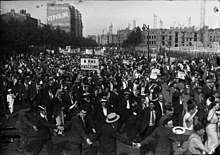

In the 1920s and 1930s in the French Third Republic, anti-fascists confronted aggressive far-right groups such as the Action Française movement in France, which dominated the Latin Quarter students' neighborhood. After fascism triumphed via invasion, the French Resistance (French: La Résistance française) or, more accurately, resistance movements fought against the Nazi German occupation and against the collaborationist Vichy régime. Résistance cells were small groups of armed men and women (called the maquis in rural areas), who, in addition to their guerrilla warfare activities, were also publishers of underground newspapers and magazines such as Arbeiter und Soldat (Worker and Soldier) during World War 2, providers of first-hand intelligence information, and maintainers of escape networks.
United Kingdom: against Mosley's BUF
The rise of Oswald Mosley's British Union of Fascists (BUF) in the 1930s was challenged by the Communist Party of Great Britain, socialists in the Labour Party and Independent Labour Party, anarchists, Irish Catholic dockmen and working class Jews in London's east end. A high point in the struggle was the Battle of Cable Street, when thousands of eastenders and others turned out to stop the BUF from marching. Initially, the national Communist Party leadership wanted a mass demonstration at Hyde Park in solidarity with Republican Spain, instead of a mobilization against the BUF, but local party activists argued against this. Activists rallied support with the slogan They shall not pass, adopted from Republican Spain.
There were debates within the anti-fascist movement over tactics. While many east end ex-servicemen participated in violence against fascists,[36] Communist Party leader Phil Piratin denounced these tactics and instead called for large demonstrations.[37] In addition to the militant anti-fascist movement, there was a smaller current of liberal anti-fascism in Britain; Sir Ernest Barker, for example, was a notable English liberal anti-fascist in the 1930s.[38]
United States, circa World War II

There were fascist elements in the United States in the 1930s such as the Friends of New Germany, the German American Bund, the Ku Klux Klan, and Charles Coughlin.[39][40][41] During the Second Red Scare which occurred in the United States in the years that immediately followed the end of World War II, the term "premature anti-fascist" came into currency and it was used to describe Americans who had strongly agitated or worked against fascism, such as Americans who had fought for the Republicans during the Spanish Civil War, before fascism was seen as a proximate and existential threat to the United States (which only occurred generally after the invasion of Poland by Nazi Germany and only occurred universally after the attack on Pearl Harbor). The implication was that such persons were either Communists or Communist sympathizers whose loyalty to the United States was suspect.[42][43][44] However, historians John Earl Haynes and Harvey Klehr have written that no documentary evidence has been found of the US government referring to American members of the International Brigades as "premature antifascists"; the Federal Bureau of Investigation, Office of Strategic Services, and United States Army records used terms such as "Communist", "Red", "subversive", and "radical" instead. Haynes and Klehr indicate that they have instead found many examples of members of the XV International Brigade and their supporters referring to themselves sardonically as "premature antifascists".[45]
Anti-fascist Italian expatriates in the United States founded the Mazzini Society in Northampton, Massachusetts in September 1939 to work toward ending Fascist rule in Italy. Political refugees from Mussolini's regime, they disagreed among themselves whether to ally with Communists and anarchists or to exclude them. The Mazzini Society joined together with other anti-Fascist Italian expatriates in the Americas at a conference in Montevideo, Uruguay in 1942. They unsuccessfully promoted one of their members, Carlo Sforza, to become the post-Fascist leader of a republican Italy. The Mazzini Society dispersed after the overthrow of Mussolini as most of its members returned to Italy.[46][47]
After World War II
The anti-fascist movements which emerged during the period of classical fascism, both liberal and militant, continued to operate after the defeat of the Axis powers in response to the resilience and mutation of fascism both in Europe and elsewhere. In Germany, for example, in 1944, as Nazi rule crumbled, veterans of the 1930s anti-fascist struggles formed "Antifaschistische Ausschüsse," "Antifaschistische Kommittees" or "Antifaschistische Aktion" groups (all typically abbreviated to Antifa).[48]
Use of the term
Christian Democratic Union of Germany (CDU) politician Tim Peters notes that the term is one of the most controversial terms in political discourse.[49] Michael Richter, a researcher at the Hannah Arendt Institute for Research on Totalitarianism, highlights the ideological use of the term in the Soviet Union and the Eastern bloc, in which the term fascism was applied to Eastern bloc dissidents regardless of any connection to historical fascism, and where the term anti-fascism served to legitimize the ruling government.[50]
See also
- Anti-authoritarianism
- Anti-capitalism
- Anti-communism
- Antifa (Germany)
- Anti-Germans (political current)
- Antifa movements
- Anti-fascist Assembly for the National Liberation of Macedonia
- Anti-fascist Assembly for the National Liberation of Serbia
- Anti-Fascist Bloc
- Anti-Fascist Committee of Cham Immigrants
- Anti-Fascist Council for the National Liberation of Yugoslavia
- Antifascist Front of Slavs in Hungary
- Anti-Fascist People's Freedom League
- Anti-racism
- Three Arrows
- Anti-Stalinist left
- Denazification
- Italian resistance movement
- Jewish Anti-Fascist Committee
- Laws against Holocaust denial
- Resistance during World War II
- Resistance movement
- Redskin (subculture)
- Slovak National Uprising
- Squadism
- Yugoslav Partisans
Notes
- Gli Arditi del Popolo (Birth) Archived 7 August 2008 at the Wayback Machine (in Italian)
- Hobsbawm, Eric (1992). The Age of Extremes. Vintage. pp. 136–37. ISBN 978-0394585758.
- Lawson, Tom (2010). Varieties of Anti-Fascism: Britain in the Inter-War Period. Palgrave Macmillan UK. pp. 119–39. ISBN 978-1-349-28231-9.
- Seidman, Michael. Transatlantic Antifascisms: From the Spanish Civil War to the End of World War II. Cambridge University Press, 2017, pp.1-8
- Seidman, Michael. Transatlantic Antifascisms: From the Spanish Civil War to the End of World War II. Cambridge University Press, 2017, p.252
- Charles F. Delzell, edit., Mediterranean Fascism 1919-1945, New York, NY, Walker and Company, 1971, p. 26
- "Anarchist Century". Anarchist_century.tripod.com. Retrieved 7 April 2014.
- David Ward Antifascisms: Cultural Politics in Italy, 1943–1946
- James Martin, 'Piero Gobetti's Agonistic Liberalism', History of European Ideas, 32, (2006), pp. 205–222.
- Pugliese, Stanislao G.; Pugliese, Stanislao (2004). Fascism, Anti-fascism, and the Resistance in Italy: 1919 to the Present. Rowman & Littlefield. p. 10. ISBN 978-0-7425-3123-9. Retrieved 11 June 2020.
- Tollardo, Elisabetta (2016). Fascist Italy and the League of Nations, 1922-1935. Springer. p. 152. ISBN 978-1-349-95028-7.
- Scala, Spencer M. Di (1988). Renewing Italian Socialism: Nenni to Craxi. Oxford University Press. pp. 6–8. ISBN 978-0-19-536396-8. Retrieved 11 June 2020.
- Milica Kacin Wohinz, Jože Pirjevec, Storia degli sloveni in Italia : 1866–1998 (Venice: Marsilio, 1998)
- Milica Kacin Wohinz, Narodnoobrambno gibanje primorskih Slovencev : 1921–1928 (Trieste: Založništvo tržaškega tiska, 1977)
- Milica Kacin Wohinz, Prvi antifašizem v Evropi (Koper: Lipa, 1990)
- Mira Cenčič, TIGR : Slovenci pod Italijo in TIGR na okopih v boju za narodni obstoj (Ljubljana: Mladinska knjiga, 1997)
- Vid Vremec, Pinko Tomažič in drugi tržaški proces 1941 (Trieste: Založništvo tržaškega tiska, 1989)
- "Intelligence and Operational Support for the Anti-Nazi Resistance". Darbysrangers.tripod.com.
- "90 let od požiga Narodnega doma v Trstu" [90 Years From the Arson of the National Hall in Trieste]. Primorski dnevnik [The Littoral Daily] (in Slovenian). 2010. pp. 14–15. COBISS 11683661. Archived from the original on 14 October 2012. Retrieved 28 February 2012.
Požig Narodnega doma ali šentjernejska noč tržaških Slovencev in Slovanov [Arson of the National Hall or the St. Bartholomew's Night of the Triestine Slovenes and Slavs]
- Sestani, Armando, ed. (10 February 2012). "Il confine orientale: una terra, molti esodi" [The Eastern Border: One Land, Multiple Exoduses] (PDF). I profugi istriani, dalmati e fiumani a Lucca [The Istrian, Dalmatian and Rijeka Refugees in Lucca] (in Italian). Instituto storico della Resistenca e dell'Età Contemporanea in Provincia di Lucca. pp. 12–13.
- Hehn, Paul N. (2005). A low dishonest decade: the great powers, Eastern Europe, and the economic origins of World War II, 1930–1941. Continuum International Publishing Group. pp. 44–45. ISBN 978-0-8264-1761-9.
- Siegfried Lokatis: Der rote Faden. Kommunistische Parteigeschichte und Zensur unter Walter Ulbricht. Böhlau Verlag, Köln 2003, ISBN 3-412-04603-5 (Zeithistorische Studien series, vol. 25), p. 60
- Eve Rosenhaft, Beating the Fascists?: The German Communists and Political Violence 1929-1933, Cambridge University Press, 25 Aug 1983, pp.3–4
- Heinrich August Winkler: Der Weg in die Katastrophe. Arbeiter und Arbeiterbewegung in der Weimarer Republik 1930–1933. Bonn 1990, ISBN 3-8012-0095-7.
- Hoppe, Bert (2011). In Stalins Gefolgschaft: Moskau und die KPD 1928–1933. Oldenbourg Verlag. ISBN 9783486711738.
- Stephan, Pieroth (1994). Parteien und Presse in Rheinland-Pfalz 1945–1971: ein Beitrag zur Mediengeschichte unter besonderer Berücksichtigung der Mainzer SPD-Zeitung 'Die Freiheit'. v. Hase & Koehler Verlag. p. 96. ISBN 9783775813266.
- Braunthal, Julius (1963). Geschichte der Internationale: 1914–1943. Vol. 2, p. 414. Dietz.
- Loren Balhorn "The Lost History of Antifa" Jacobin May 2017
- Friedmann, Sarah (15 August 2017). "This Is What The Antifa Flag Symbols Mean". Bustle. Retrieved 16 April 2019.
- Hobsbawm, Eric (17 February 2007). "The Spanish civil war united a generation of young writers, poets and artists in political fervour, says Eric Hobsbawm". The Guardian. ISSN 0261-3077. Retrieved 5 June 2020.
- Stevens, David R. (19 June 2008). Sin Perdón. AuthorHouse. ISBN 978-1-4343-8094-4.
- The Literary Digest. Funk & Wagnalls. April 1929.
- De Miguel, Jesús y Sánchez, Antonio: Batalla de Madrid, in his Historia Ilustrada de la Guerra Civil Española. Alcobendas, Editorial LIBSA, 2006, pp. 189–221.
- Boadilla by Esmond Romilly. The Clapton Press Limited, London. 2018. ISBN 978-1999654306
- See "Wolf Moon" by Julio Llamazares, Peter Owen Publications, London 2017 ISBN 978-0720619454
- Jacobs, Joe (1991) [1977]. Out of the Ghetto. London: Phoenix Press.
- Phil Piratin Our Flag Stays Red. London: Lawrence & Wishart, 2006.
- Andrezj Olechnowicz, 'Liberal anti-fascism in the 1930s the case of Sir Ernest Barker', Albion 36, 2005, pp. 636–60
- https://web.archive.org/web/20180124131225/http://www.traces.org/americanbund.html
- Chip Berlet, Matthew Nemiroff Lyons (2000). Right-Wing Populism in America: Too Close for Comfort. Guilford Press. ISBN 978-1-57230-562-5.
- Shaffer, Ryan (Spring 2010). "Long Island Nazis: A Local Synthesis of Transnational Politics". 21 (2). Journal of Long Island History. Archived from the original on 21 June 2010. Retrieved 19 November 2010.
- Premature antifascists and the Post-war world Archived 31 December 2013 at the Wayback Machine, Abraham Lincoln Brigade Archives Bill Susman Lecture Series. King Juan Carlos I of Spain Center at New York University, 1998. Retrieved 9 August 2009.
- Knox, Bernard (Spring 1999). "Premature Anti-Fascist". Antioch Review. 57 (2): 133–49. doi:10.2307/4613837. JSTOR 4613837.
- John Nichols (26 October 2009). "Clarence Kailin: 'Premature Antifascist' – and proudly so". Cap Times. Capital Times (Madision, Wisconsin). Retrieved 29 December 2013.
- Haynes, John Earl; Klehr, Harvey (2005). In Denial: Historians, Communism & Espionage. San Francisco: Encounter Books. p. 123. ISBN 978-1594030888. Retrieved 22 March 2014.
- Tirabassi, Maddalena (1984–1985). "Enemy Aliens or Loyal Americans?: the Mazzini Society and the Italian-American Communities". Rivista di Studi Anglo-Americani (4–5): 399–425.
- Morrow, Felix (June 1943). "Washington's Plans for Italy". Fourth International. 4 (6): 175–179. Retrieved 25 October 2018.
- Balhorn, Loren (8 May 2017). "The Lost History of Antifa". Jacobin.
- Peters, Tim (2007). Der Antifaschismus der PDS aus antiextremistischer Sicht [The antifascism of the PDS from an anti-extremist perspective]. Springer. pp. 33–37 and p. 186. ISBN 9783531901268.
- Richter, Michael (2006). "Die doppelte Diktatur: Erfahrungen mit Diktatur in der DDR und Auswirkungen auf das Verhältnis zur Diktatur heute". In Besier, Gerhard; Stoklosa, Katarzyna (eds.). Lasten diktatorischer Vergangenheit – Herausforderungen demokratischer Gegenwart. LIT Verlag. pp. 195–208. ISBN 9783825887896. External link in
|chapter=(help)
Bibliography
- Copsey, Nigel (2016). Anti-Fascism in Britain. Taylor & Francis. ISBN 978-1-317-39762-5.
- Diner, Dan; Gundermann, Christian (1996). "On the Ideology of Antifascism". New German Critique (67): 123–132. doi:10.2307/827781. ISSN 0094-033X.
- Eley, Geoff (1996). "Legacies of Antifascism: Constructing Democracy in Postwar Europe". New German Critique (67): 73–100. doi:10.2307/827778. ISSN 0094-033X.
- Jarausch, Konrad H. (1991). "The Failure of East German Antifascism: Some Ironies of History as Politics". German Studies Review. 14 (1): 85–102. doi:10.2307/1430155. ISSN 0149-7952.
- Mammone, Andrea (2006). "A Daily Revision of the Past: Fascism, Anti-Fascism, and Memory in Contemporary Italy". Modern Italy. 11 (2): 211–226. doi:10.1080/13532940600709338. ISSN 1353-2944.
- Rabinbach, Anson (1996). "Introduction: Legacies of Antifascism". New German Critique (67): 3–17. doi:10.2307/827774. ISSN 0094-033X.
Further reading
| Library resources about Anti-fascism |
- David Berry "‘Fascism or Revolution!’ Anarchism and Antifascism in France, 1933–39" Contemporary European History Volume 8, Issue 1 March 1999, pp. 51–71
- Birchall, Sean, ed. (2013). Beating The Fascists: The Untold Story of Anti-Fascist Action. ISBN 978-1-904491-12-5.
- Brasken, Kasper. "Making Anti-Fascism Transnational: The Origins of Communist and Socialist Articulations of Resistance in Europe, 1923–1924." Contemporary European History 25.4 (2016): 573–596.
- Bray, Mark (2017). Antifa: The Anti-Fascist Handbook. New York: Melville House. ISBN 978-1612197036. OCLC 1016082358.
- Bullstreet, K. (2001). Bash the Fash: Anti-Fascist Recollections 1984–1993. ISBN 978-1-873605-87-5.
- Class War/3WayFight/Kate Sharpley Library Interview from Beating Fascism: Anarchist Anti-Fascism in Theory and Practice, anarkismo.net
- Copsey, N. (2011) ."From direct action to community action: The changing dynamics of anti-fascist opposition", in Copsey, N. and Macklin, G. D. (eds) British National Party: Contemporary perspectives. Routledge
- Nigel Copsey & Andrzej Olechnowicz (eds.), Varieties of Anti-fascism. Britain in the Inter-war Period, Palgrave Macmillan
- Gilles Dauvé "Fascism/Antifascism", libcom.org
- David Featherstone "Black Internationalism, Subaltern Cosmopolitanism, and the Spatial Politics of Antifascism" Annals of the Association of American Geographers Volume 103, 2013, Issue 6, pp. 1406–1420
- Joseph Fronczak "Local People’s Global Politics: A Transnational History of the Hands Off Ethiopia Movement of 1935" Diplomatic History, Volume 39, Issue 2, 1 April 2015, pp. 245–274
- Hugo Garcia, ed, Transnational Anti-Fascism: Agents, Networks, Circulations Contemporary European History Volume 25, Issue 4 November 2016, pp. 563–572
- Key, Anna, ed. (2005). Beating Fascism: Anarchist anti-fascism in theory and practice. ISBN 978-1-873605-88-2.
- Renton, Dave. Fascism, Anti-fascism and Britain in the 1940s. Springer, 2016.
- Enzo Traverso "Intellectuals and Anti-Fascism: For a Critical Historization" New Politics, vol. 9, no. 4 (new series), whole no. 36, Winter 2004
External links
| Wikimedia Commons has media related to Antifascist resistance. |
| Wikiquote has quotations related to: Anti-fascism |

